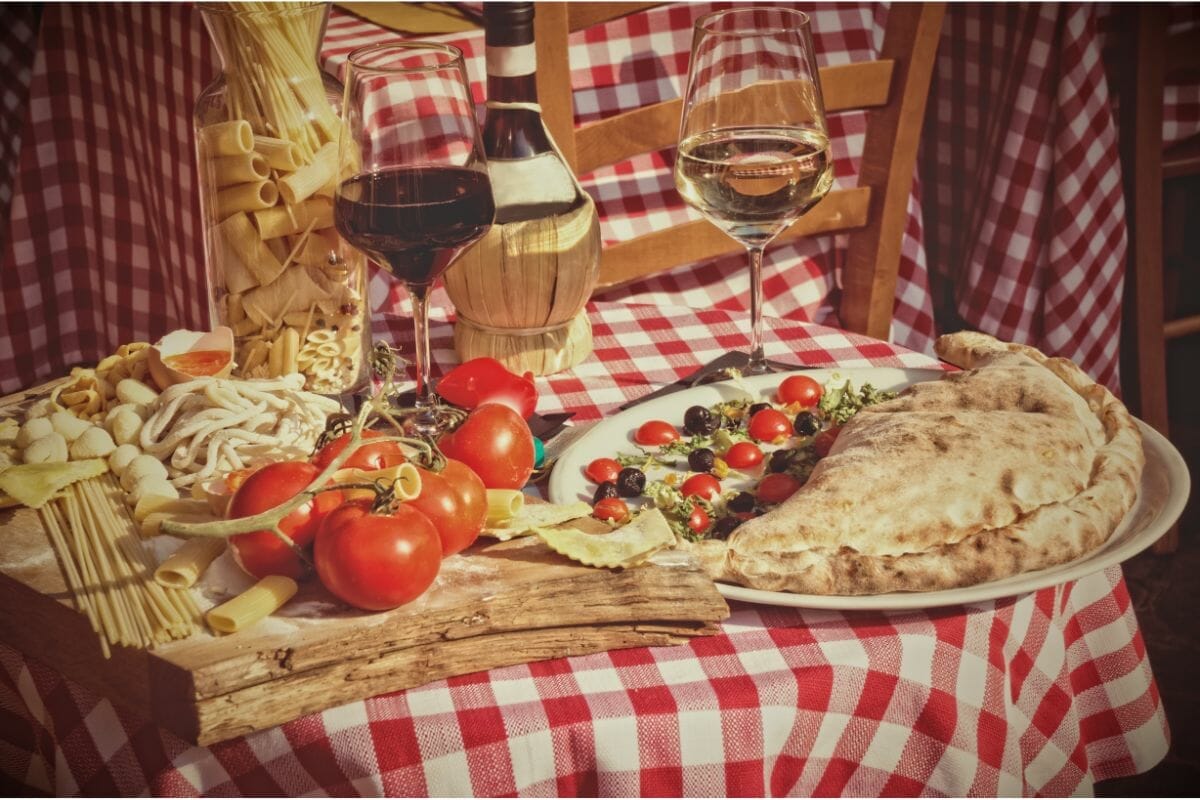Italian food is arguably some of the best food in the world. What makes it even better, though, is pairing your favorite Italian dish with the perfect glass of wine.
If you’re not an experienced wine connoisseur, however, it can be difficult to know which wine to pair with which Italian dish for the best flavor combination.

Italy is a country known for its incredible wines as well as its delicious pasta dishes. Because of this, we’ll be dedicating most of this guide to pasta and wine pairings.
However, we’ll also be covering the best wines to pair with other classic Italian dishes, such as risotto and pizza (see also “Sangiovese Vs Chianti: Must-Know Italian Wine“).
Once you’ve read this guide, you’ll know exactly what to order from the wine list or pick up from the store for your next Italian meal!
Is Red Or White Wine Best For Italian Food?
Before we get started with individual food and wine pairings, a lot of people ask the question: ‘Should I drink red or white wine with Italian food?’
There’s no simple answer to this question because, as we’ll see later in our guide, some Italian dishes go better with white wine, while others go best with a rich red.
The good news if you’re really stuck on which wine to order is that you’ll usually be safe with a red wine. Red wines tend to be more acidic than wine, which means they generally pair well with most Italian dishes.
As a rule of thumb, though, if you’re thinking of ordering an Italian dish with a creamy or buttery sauce, you may sometimes want to order a white wine. This all depends on the specific ingredients and flavors.
On the other hand, many Italian dishes are made with tomato sauce. For example, spaghetti bolognese or pizza. In this case, you may prefer a red wine to match the acidity of the tomato.
Read on to find out which wines pair best with the most popular Italian dishes!
Italian Food And Wine Pairings
Best Wine For Carbonara
Carbonara is one of the most popular pasta dishes in the world, so naturally, many people want to know which wine they should pair with this creamy pasta.
Carbonara uses ingredients such as Parmesan cheese, eggs, and pancetta. Therefore, it’s quite rich.
Whereas a lot of rich and creamy pasta dishes go well with white wine, we would personally recommend a red wine for Carbonara. That’s because the sauce is so rich that a more acidic wine will help to balance out that richness.
In our opinion, Carbonara goes best with high-acidity red wines, such as Pinot Noir, Chianti, Sangiovese, or Russian River.
Wine Pairing For Chicken Parmesan
Another popular dish from Italy that has become famous throughout the US and other parts of the world is Chicken Parmesan.
This dish sometimes comes with a side of pasta, but the main components are tomato sauce, Parmesan and mozzarella cheese, and chicken.
Now, you may come across recommendations for white wine pairings with chicken dishes, and this is usually great advice. However, for Chicken Parmesan specifically, we tend to recommend red wines.
This is because Chicken Parmesan is a hearty dish with a lot of bold flavors from the tomato and cheese. Most white wines won’t be able to compete with these flavors, so a fuller red wine is the better choice.
Low-tannin, high-acidity red wine with notes of fruit and dried herbs will always go well with Chicken Parmesan. So, we recommend something like Pinot Noir, Barbera, Chianti Classico, or Dolcetto.
What To Drink With Pesto Pasta
Pesto is a delicious pasta sauce, bursting with fresh and potent flavors, so when it comes to choosing a wine to accompany your pesto pasta, it’s worth giving this pairing some thought.
For those who aren’t familiar with the ingredients in pesto sauce, it contains Parmesan cheese, pine nuts, olive oil, and basil.
Because these flavors are fresh, light, and non-acidic, we recommend a high-acidity white wine with herbal notes. This will complement the flavor of the pesto perfectly.
You have many different options when pairing pesto pasta with wine. A Sauvignon Blanc should never disappoint, but you can also choose an unoaked Chardonnay, such as a Chablis.
Other recommendations include Pinot Gris, Grüner Veltliner, and Albariño.
Spaghetti Wine Pairings
Spaghetti is one of the most well-known types of pasta, but it can be prepared in many different ways, which makes finding the perfect wine pairing a challenge.
Most spaghetti sauce is tomato-based and fairy acidic. Therefore, we typically recommend a red wine such as Nebbiolo, Zinfandel, or Merlot.
However, depending on your preference, you could also pair white wine, such as Riesling, Sauvignon Blanc, or Pinot Grigio with spaghetti.
If your spaghetti dish also contains meat, like meatballs, for example, we definitely recommend a full-bodied red wine, such as Zinfandel, Merlot, Cabernet Sauvignon, or Nebbiolo.
We also suggest adding a dash of your preferred wine to the spaghetti sauce during the cooking process. This will really help to bring the flavors of the sauce and the wine together.

Best Pasta Primavera Wine
Pasta Primavera is a light and fresh pasta dish, so you need a wine that will help to complement these flavors.
Pasta Primavera is packed with vegetables, so we recommend a white wine with light and refreshing flavors, including herbaceous notes, with a high level of acidity.
This is generally the best choice for enhancing fresh vegetable flavors.
A dry Muscat is the perfect addition to a Primavera pasta dish, and we also love it with Sauvignon Blanc.
Ideal Wine for Shrimp Scampi
When it comes to Italian seafood dishes, your ideal wine pairing will usually be a white wine. Shrimp Scampi is no exception.
We love to pair Shrimp Scampi with crisp white wines. Unoaked white wines will taste best with seafood, especially if they have citrus notes. Pinot Grigio and Chardonnay are our pairings of choice for this dish.
Adding a dash of your chosen white wine to the sauce will help to enhance the flavors of both the sauce and the wine even further.
Choosing Wine for Fettuccine Alfredo
If you love hearty and creamy pasta dishes, you’ve almost definitely heard of Fettuccine Alfredo.
Because Fettuccine Alfredo comes with a rich and creamy sauce, we like to pair it with a fruity and acidic white wine, such as Pinot Grigio or Chardonnay.
Wine to Pair with Vodka Sauce
Vodka sauce, despite the name, does not actually taste like Vodka. While it is made with alcohol, this is cooked off during the cooking process.
So, the main flavors you need to consider when choosing a wine to pair with Vodka sauce are creamy and tomato.
When it comes to vodka sauce, you have a lot of options open to you. A red wine with fruity notes, such as Sangiovese, always works well. As long as the acidity isn’t too much, red wines generally go well with Vodka sauce.
However, you can also choose a light white wine, such as Pinot Grigio, Moscato, or Sauvignon Blanc, to accompany this pasta dish.
The main thing is to make sure the acidity of your chosen wine is not too high, otherwise, it will be too much with the acidic flavor of the tomato in the sauce.
Wines To Enjoy with Manicotti
Manicotti pasta is made with a combination of cheeses, such as mozzarella, ricotta, and Parmesan, along with eggs. Therefore, this is a deliciously creamy dish that needs the right wine for the perfect flavor combination.
Since the sauce for Manicotti is so creamy, you should be looking for a fairly acidic wine to accompany it. A Barbera, Chianti, or Montepulciano would work beautifully if your preference is red wine.
However, if you’d like to choose a white wine instead, Friulano, Pinot Grigio, or Soave are all excellent choices.
Drinking Wine With Cacio e Pepe
Cacio e Pepe is a delicious, cheesy Italian pasta dish, typically seasoned with basil. While this pasta is delicious on its own, it’s even better with the perfect wine.
The rich flavors from the cheese, along with the herbaceous flavors, mean that you can pair Cacio e Pepe with either red or white wine.
We often pair Cacio e Pepe with Sangiovese because of its fruity notes and acidity level. Sangiovese is an excellent palate cleanser alongside the richness of the cheesy sauce.
However, a dry white wine, like Riesling, can also be refreshing with Cacio e Pepe. Just make sure it has a bright flavor with fruit notes to complement the dish perfectly.
Best Wine Pairing For Risotto
Risotto is a rice-based Italian dish that can feature many different ingredients and flavors. Because of this, you’ll need to consider the components of the specific risotto dish before choosing a wine to go with it.
If all you know is that you need a wine to pair with risotto, but aren’t sure of the individual ingredients, you can be safe with a Gavi wine. Gavi is a white wine similar to Chablis.
It’s dry and crisp, with a slightly nutty flavor that goes well with almost any kind of risotto.
However, if you know exactly what kind of risotto you’ll be having, choosing the perfect wine is much easier.
For a mushroom risotto, particularly when prepared with a strong cheese like Parmesan, an aged white wine such as Chardonnay, Chenin Blanc, Riesling, or Grüner Veltliner, will work perfectly.
Seafood risottos also tend to go well with white wines like Chardonnay. A crisp and light white wine will complement the milder flavors of seafood and rice without overpowering them.
For a tomato-based risotto, Chardonnay also works, but you could branch out with an Australian Shiraz, or a German Riesling.

Wine To Serve With Lasagna
Lasagna features both creamy white sauce and tomato sauce along with pasta sheets. Therefore, the best type of wine to pair with lasagna is both fruity and acidic.
This is generally the type of wine that contains the most flavor, which is exactly what you want to hold up against the layers of flavor you get in a lasagna.
Our favorite wines to pair with Lasagna include Barbera, Chianti Classico, Pinot Noir, Dolcetto, Nero d’Avola, and Zinfandel.
Top Pizza Wine Pairings
Like risotto, the best wine pairing for pizza depends on the ingredients, or more specifically, the toppings.
As you probably know, pizza comes with a wide variety of toppings, from your standard Margherita (tomato and cheese) to meat pizzas, vegetable pizzas, and even seafood pizzas.
Margherita pizza can be served with either red or white wine. Even a Mediterranean rose, as long as it’s full-bodied, can work very well. We recommend Pinot Grigio as a white wine, or a fruity red like Barbera.
Wine that Goes With Arancini
Arancini are fried rice balls that have been coated with breadcrumbs and stuffed with ingredients such as sundried tomatoes, herbs, or pesto. These Sicilian delicacies are best when paired with a crisp, acidic white wine, ideally with a lot of fresh flavors.
You can’t go wrong with Pinot Grigio, but Sauvignon Blanc also works. We might recommend a German Riesling or an Australian Shiraz as an alternative.
Italian Charcuterie Wine Recommendations
While the word ‘Charcuterie’ comes from France, Italian-style charcuterie is also very popular. Italian meats that fall under the charcuterie umbrella include salami, pancetta, prosciutto, guanciale, and more processed meats.
Since Italian charcuterie can be very salty, it’s best to choose a light and refreshing wine to accompany your platter. We recommend Riesling or Pinot Grigio. Prosecco and rosé wines can also be a great accompaniment to Italian charcuterie.
If you’re a big fan of red wine, you can also pair Italian meats with a light red. Barbera is a good choice thanks to its fruity notes, but we also recommend Beaujolais or Lambrusco.
Wine For Tiramisu
Tiramisu is one of the most well-known and traditional Italian desserts.
You have to be careful when choosing a wine to pair with Tiramisu because this dish already contains alcohol, and you want both your wine and the dark rum in the dessert to hold their own.
We usually recommend a sweet red wine to go with Tiramisu. This is because there are strong flavors in the dessert already, so a little fruity sweetness from the wine can help to add balance.
A dessert wine like Port, Marsala, Sherry, Moscato Rosa, or Vin Santo is the best choice.
Best Wine Pairings For Gelato
Gelato, or Italian ice cream, is creamy and flavorful. It comes in many different flavors, and your chosen flavor should be your guide when choosing a wine.
Chocolate or coffee gelatos go well with red wines such as Cabernet Sauvignon or Merlot. For red fruit flavors, such as strawberry, we often recommend a rosé wine of your choice.
A vanilla gelato will have a more delicate flavor that you don’t want to overpower, so a light, sparkling wine would be our recommendation.
Since gelato comes in so many flavors, if you’re ordering at a restaurant, it might be a good idea to ask your server what they recommend.
Final Thoughts
There is no single wine recommendation for Italian food, because Italian cuisine is so varied in terms of flavor and ingredients.
When it comes to pasta dishes, your choice of wine should be based on the sauce as well as other ingredients, such as different proteins.
Creamy sauces go best with red wines, whereas tomato sauces can be accompanied by either red or white wines, depending on the exact type of sauce.
Pizzas and rice-based dishes can include a wide variety of ingredients, and your wine pairing should be chosen with these flavors in mind. Italian desserts usually go best with sweet red wines, such as fruity dessert wines.
Frequently Asked Questions
If you don’t drink alcohol, you might find yourself wondering what you should drink to complement the flavors of Italian food.
Although alcoholic wine is off the table if you don’t drink alcohol, you can find non-alcoholic versions of many of the wines we’ve suggested in this guide.
Whether you’re looking for an acidic red wine to go with your pizza or a light and crisp white wine for your seafood pasta, you should be able to find a version that contains zero alcohol.
Creamy Italian dishes, including pasta dishes, go well with a simple glass of water or a light soda such as lemonade for refreshment. This applies to pizza, too.
Wine is an excellent accompaniment to Italian food, but it’s traditional to drink a different kind of alcoholic beverage once the meal is finished.
In Italy, a digestif, known in Italian as a digestivo, is served after a meal to improve digestion. This is a kind of Italian liquor; usually either Strega, Limoncello, Fernet Branca, Passito, or Amaro.
We often recommend choosing your wine before you start cooking Italian food. This is because it allows you to add a splash of your chosen wine into any sauces to enhance the compatibility of the flavors.
However, some wines are better for cooking than others.
Red wines like Merlot, Pinot Noir, and Cabernet Sauvignon typically cook nicely. However, you can also cook with fortified wines, which are best for enhancing complex flavors. These include Sherry, Madeira, Port, and Marsala.
In traditional Italian restaurants, only wine and water are served alongside meals. It’s also frowned upon to order ice in either your water or wine.
- Moscato vs Roscato: A Comprehensive Comparison of Sweet Wines - December 15, 2023
- Should White Wine Be Chilled? Expert Insights on Serving Temperature - December 14, 2023
- Moscato vs Riesling: A Sweet Wine Showdown - December 8, 2023










